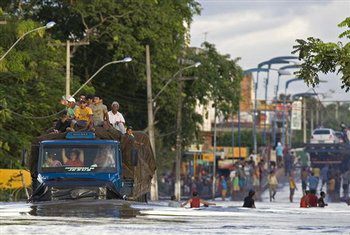
|  |  |  Americas & Beyond | May 2009 Americas & Beyond | May 2009  
Brazilians Avoid Deadly Reptiles in Fleeing Floods
 Marco Sibaja - Associated Press Marco Sibaja - Associated Press
go to original


| | Residents ride on top of a truck along a flooded street in Itapecuru Mirim, in the northeast state of Maranhao, Brazil Thursday, May 7, 2009. Floods have killed at least 32 and left nearly 200,000 homeless across a vast region stretching from the Amazon jungle to the northeastern Atlantic coast as meteorologists predict the bad weather could last for weeks.(AP/Andre Penner) |  |
Corimata da Cima, Brazil — Northern Brazil's worst floods in decades have driven 218,000 people from their homes to seek refuge wherever they can, packing onto flatbed trucks and braving rivers teeming with deadly reptiles in a scramble for higher ground.

Already, 36 people have been killed in the flooding, sparked by unusually heavy rains that have been falling for two months on 10 of Brazil's 26 states. Three times the size of Alaska, the affected area stretches from the normally wet rainforest to coastal states known for lengthy droughts.

Meteorologists blame an Atlantic Ocean weather system that typically moves on by April – and they forecast weeks more of the same.

Maria do Remedio Santos, whose fields of rice and manioc lay ruined underwater on Thursday, said it was time to join those fleeing for safety. Heavy rains had begun seeping into her mud-brick, thatched-roof home, where nine relatives and neighbors were camped out. Outside, the dirt road was a muddy river.

"For now we're all sleeping in the living room, but we're going to have to leave," she said. "There's no other way out."

Some shelters were already packed with people, pets and livestock, and had little food or medical supplies. Even fleeing presented its own perils: In the same newly formed rivers that flood victims waded through or plied with canoes swam anacondas, rattlesnakes and legless, rodent-eating "worm lizards," whose bite is excruciating.

"So far no one has been bitten here. The main thing you tell the kids is to stay out of the water," Palmeiro da Costa said from a canoe in the town of Sao Miguel de Rosario.

Alligators swam through the city of Santarem, civil defense official Walkiria Coelho said. Scorpions congregated on the same high ground as people escaping the rising water. No injuries were reported.

Authorities worried about thousands of people isolated for days with little food or clean water, rushing aid to towns and cities. In some places, aid was stuck because there were no local workers to distribute it, said Maj. Wellington Soares Araujo, head of civil defense logistics in the hardest-hit state of Maranhao.

Rivers were still rising as much as a foot (30 centimeters) a day in Maranhao. The surging torrents wrecked bridges and made it too dangerous for relief workers to take boats onto some waterways. Globo TV said planes were unable to land in remote areas of Piaui state and roads were impassable, leaving boats as the only option because helicopters were not available.

"It's really hard for some areas that don't have any civil defense infrastructure," Araujo said.

The army evacuated thousands of people from two Maranhao towns where tiled roofs barely poked above swirling waters. Residents packed into gyms and schools and huddled in tents.

"There are no houses, there isn't enough food, they even have a shortage of tents," Araujo said.

Television images showed hundreds of people in one city with pets and chickens crowded inside an abandoned hospital-turned-shelter with only one working bathroom. In another, the homeless took refuge in an animal exhibition center, setting up camp in filthy stables.

In the town of Itapecuru Mirim, residents stood on the back of flatbed trucks fleeing town. Tractors hauled trailers full of people trying to make it to higher ground.

Isolated cases of looting were reported in communities cut off by high water.

The mighty Rio Negro River that feeds the Amazon was just three feet (one meter) below a record set in 1953 near the jungle city of Manaus, and experts said the record could be broken by June. In the jungle city of Altamira, more rain fell in three hours than normally falls in two months, Mayor Odileida Sampaio told the state-run Agencia Brasil news agency.

"We don't know yet, but this could end up being the worst flooding ever in the region," said Joaquim Godim, a specialist with Brazil's National Water Agency. "It certainly is among the worst ever."

Near Altamira, Ocilene Ferreira da Silva barely had time to put her two young daughters into a canoe after a small dam collapsed.

"My neighbor came in screaming that the water was rising really fast, and then all of a sudden the water came rushing into my house," said Silva, 23. "It swept away all the dogs, cats and even parrots. It took everything."

Even as rains pounded the north, parts of southern Brazil are suffering through a two-month drought that has dried up the famed Iguazu falls, one of South America's leading tourist attractions, to less than a third of normal volume.

Some environmentalists said the Amazon wouldn't be hurt by the floods because the rain forest and its inhabitants have endured them for centuries.

But Paulo Barreto, a researcher at the Amazon Institute of People and the Environment, said the flooding comes just four years after a major drought. He blamed climate change and said such events put stress on the environment "that could affect the survival of plant and animal species."

Associated Press writers Tales Azzoni, Alan Clendenning, Carolina Escalera and Stan Lehman contributed to this report from Sao Paulo. |

 |
|  |



